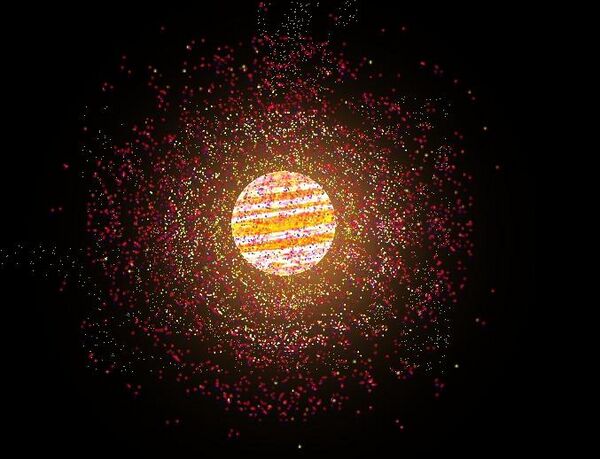Matrioshka Micronodes (A1-0): Difference between revisions
No edit summary |
No edit summary |
||
| Line 1: | Line 1: | ||
''[[Infrastructures And Megastructures In The Galactyan Empire (A1-0)|<small><u>Go back to the main List</u></small>]]'' | ''[[Infrastructures And Megastructures In The Galactyan Empire (A1-0)|<small><u>Go back to the main List</u></small>]]'' | ||
[[File:Kantheana_Matryoshka_MicroNodule.jpg|thumb|600x600px|'''''A Matryoshka Micronode around the stellified gas giant Vivitur.''''']] | [[File:Kantheana_Matryoshka_MicroNodule.jpg|thumb|600x600px|'''''A Matryoshka Micronode around the stellified gas giant Vivitur.''''']] | ||
A '''Matryoshka MicroNode''' is a '''multi-layered megaconstellation of orbiting processors''', acting as a smaller and more compact version of the standard [[Matryoshka Hypernode (A1-0)|'''Matrioshka''']] processing node, constructed around a '''stellified jovian or brown dwarf''' type body. While Micronodes are far less computationally powerful than a stellar class node, they are much less resource intensive and considerably easier to construct. | |||
== '''Structure''' == | |||
Micronodes are usually constructed by first introducing a '''Stellification Engine''' into a gas giant or brown dwarf and allowing it convert the body into a source of radiant energy. The various moons, asteroids, and ring materials orbiting the body are then reconstructed into multiple layers of orbiting processor elements in standard Matrioshka fashion. The resulting processing environment is used to run resource intensive simulations, provide computational support to the local polity or civilization, or support large populations of AI, upload, and a-life sapients. | |||
When preparing to build a micronode, care is taken to map the gravitational and orbital dynamics of the local system. Unlike a stellar class Matrioshka node, the completion of a micronode generally leaves a number of planets, companion stars, and other bodies extant in local space, any or all of which could disrupt or even damage the structure and elements of the node at some point in its future. To minimize or prevent such occurrences, micronodes are generally only placed in areas where it is deemed that future disruptions will be minimized. Further, since the future state of even the most stable seeming locale can only be predicted to a limited degree due to chaos effects, virtually all micronodes incorporate local and deep space monitoring systems, '''Effector Frame Modules''' to shift smaller intrusive bodies into safe orbits, and '''Maneuvering Thrusters''' of various sorts in the structure of the node elements to avoid or correct for any disturbances that may occur. While standard Matrioshka nodes also certainly include such systems, micronodes tend to incorporate a much larger percentage of their overall mass (comparatively speaking) into these devices than their larger counterparts. | |||
Revision as of 21:46, 16 December 2023

A Matryoshka MicroNode is a multi-layered megaconstellation of orbiting processors, acting as a smaller and more compact version of the standard Matrioshka processing node, constructed around a stellified jovian or brown dwarf type body. While Micronodes are far less computationally powerful than a stellar class node, they are much less resource intensive and considerably easier to construct.
Structure
Micronodes are usually constructed by first introducing a Stellification Engine into a gas giant or brown dwarf and allowing it convert the body into a source of radiant energy. The various moons, asteroids, and ring materials orbiting the body are then reconstructed into multiple layers of orbiting processor elements in standard Matrioshka fashion. The resulting processing environment is used to run resource intensive simulations, provide computational support to the local polity or civilization, or support large populations of AI, upload, and a-life sapients.
When preparing to build a micronode, care is taken to map the gravitational and orbital dynamics of the local system. Unlike a stellar class Matrioshka node, the completion of a micronode generally leaves a number of planets, companion stars, and other bodies extant in local space, any or all of which could disrupt or even damage the structure and elements of the node at some point in its future. To minimize or prevent such occurrences, micronodes are generally only placed in areas where it is deemed that future disruptions will be minimized. Further, since the future state of even the most stable seeming locale can only be predicted to a limited degree due to chaos effects, virtually all micronodes incorporate local and deep space monitoring systems, Effector Frame Modules to shift smaller intrusive bodies into safe orbits, and Maneuvering Thrusters of various sorts in the structure of the node elements to avoid or correct for any disturbances that may occur. While standard Matrioshka nodes also certainly include such systems, micronodes tend to incorporate a much larger percentage of their overall mass (comparatively speaking) into these devices than their larger counterparts.